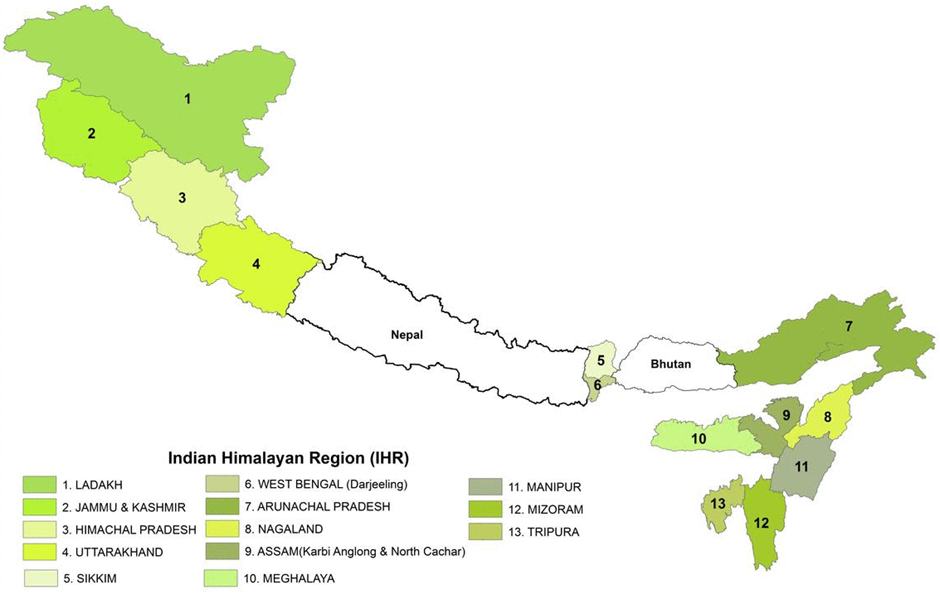Facts for UPSC Mains
Towards Resilient Indian Himalayan Region
- 04 Aug 2025
- 8 min read
Why in News?
The Supreme Court of India has raised alarm over unchecked infrastructure development, unregulated tourism, and ecological degradation in Himachal Pradesh.
- It highlights the urgent need for sustainable, ecologically sensitive governance and climate-resilient development models to safeguard the Indian Himalayan region’s future.
Indian Himalayan Region
- The Indian Himalayan Region is stretching across 2500 km covers 13 Indian States/Union Territories (namely Jammu and Kashmir, Ladakh, Uttarakhand, Himachal Pradesh, Arunachal Pradesh, Manipur, Meghalaya, Mizoram, Nagaland, Sikkim, Tripura, Assam and West Bengal)
- It covers approximately 16.2% of India’s geographical area and supports over 50 million people directly.
- The vegetation ranges from tropical forests (in the foothills) to temperate forests (in the middle ranges) to alpine meadows (at higher altitudes).
- As the “Water Tower of India”, they feed 10 major rivers including the Ganga and Indus, sustaining agriculture and drinking water for over 600 million people.
- Ecologically, they host 3,160+ endemic plant species, rare fauna like the snow leopard, and span multiple climate zones.
- Economically, they support organic farming (e.g., Sikkim model), tourism contributing over 10% to hill states' GDP, and major hydropower projects like Arunachal’s 13,000 MW Lohit Basin initiative.
- Strategically, they shield India against potential geopolitical threats.
What are the Key Threats that the Indian Himalayan Region is Facing?
- Significant Forest Loss: Between 2019 and 2021, the Himalayan states experienced a loss of 1,072sqkm of forest cover, increasing vulnerability to landslides, biodiversity loss, and soil erosion.
- Decline in Natural Springs: Nearly 50% of natural springs across the Indian Himalayan Region are drying up (NITI Aayog), leading to water scarcity and impacting local communities’ water needs for drinking, agriculture, and sanitation.
- Glacier Retreat: Himalayan glaciers are retreating rapidly, increasing the risk of Glacial Lake Outburst Floods (GLOFs). For instance, Arunachal Pradesh alone has lost 110 glaciers over the past 32 years, signalling an alarming trend of cryospheric degradation.
- GLOFs have claimed over 12,000 lives in the past 200 years.
- Rise in Landslides: Increased land use for development have made certain Himalayan states (e.g., Himachal Pradesh) highly landslide-prone, often triggered or worsened by heavy rainfall and infrastructural development.
- Deforestation and construction have accelerated soil erosion, slope instability, and loss of soil fertility, fueling more frequent landslides and land subsidence incidents, such as witnessed in Joshimath in 2023.
What are the Key India’s Initiatives Related to the Indian Himalayan Region?
What Measures can be Adopted to Promote Sustainable Development in the Himalayan Region?
- Eco-Friendly Infrastructure Development: Enforce scientific slope cutting and tunneling techniques to prevent landslides.
- Promote green buildings using local materials and energy-efficient designs.
- Adopt the “Build Less, Build Smart” principle for sustainable hill architecture.
- Water Resource Conservation: Restore and maintain springs, natural aquifers, and catchments under programs like Jal Shakti Abhiyan.
- Promote rainwater harvesting and micro-irrigation systems in farms and hill settlements.
- Ecotourism and Sustainable Livelihoods: Shift from mass tourism to eco-tourism and homestays, with strict carrying capacity norms.
- Train local youth as nature guides, biodiversity monitors, and in handicraft-based livelihoods.
- Implement waste management rules in hill towns and tourist hotspots.
- Forest and Biodiversity Conservation: Promote community-based forest management (e.g., Van Panchayats in Uttarakhand).
- Promote plantation of indigenous tree species to reduce slope erosion and enhance carbon sequestration.
- Disaster-Resilient Planning: Mandate hazard zoning maps in all construction approvals. Expand early warning systems for landslides, flash floods, and GLOFs.
- Promote climate-resilient rural housing under PM Awas Yojana (Gramin) in fragile zones.
- Use of Technology and Data: Use remote sensing, drones, and GIS for monitoring deforestation, slope instability, and glacial changes.
- Develop real-time dashboards for tourist pressure, weather alerts, and construction tracking.
- Deploy IoT sensors in dams and rivers to monitor water flow and outburst risks.
Related Keywords for Mains
- Climate & Cryosphere
- “From Ice Reserves to Risk Reservoirs” – Glacial lakes turning into GLOF threats.
- “Cryospheric Collapse” – Impact of rising temperatures on glacier stability.
- Development vs Ecology
- “Four Lanes into Fragility” – Highway projects weakening mountain slopes.
- “From Eco-Zones to Erosion Zones” – Poorly planned development disrupting natural systems.
- Conservation & Sustainability
- “Ecology is Elevation’s Insurance” – Environment is critical for mountain safety.
- “Green Altitudes, Not Grey Attitudes” – Promoting eco-sensitive infrastructure in hills.
- Governance & Policy
- “Combining Environmental Impact Assessment (EIA) with Ecological Impact Consciousness (EIC)” – Making sustainability a mindset, not just a checklist.
- “From GDP to GEP (Gross Ecological Product)” – Incorporating ecological value in policy metrics.
|
Drishti Mains Question: The Indian Himalayan Region is becoming a hotspot for climate-induced disasters. Discuss the role of governance, community participation, and scientific planning in building resilience. |
Mains:
Q1. Differentiate the causes of landslides in the Himalayan region and Western Ghats. (2021)
Q2. How will the melting of Himalayan glaciers have a far-reaching impact on the water resources of India? (2020)
Q3. “The Himalayas are highly prone to landslides.” Discuss the causes and suggest suitable measures of mitigation. (2016)







